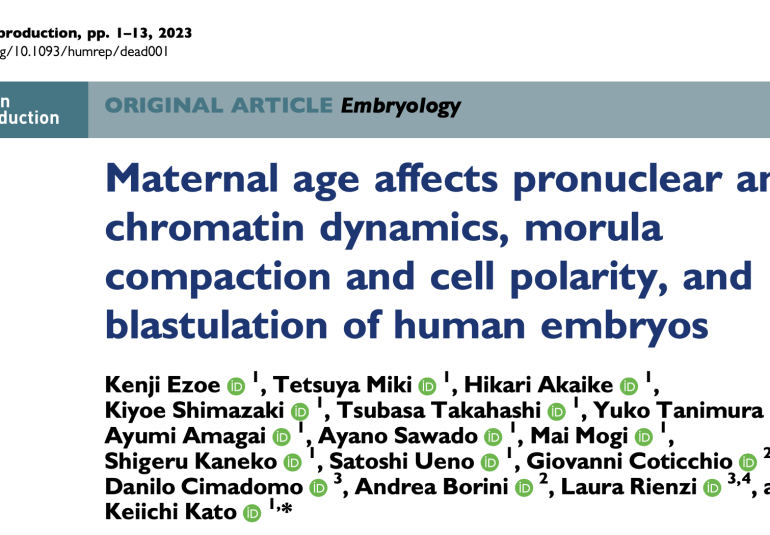
Kenji Ezoe, Tetsuya Miki, Hikari Akaike, Kiyoe Shimazaki, Tsubasa Takahashi, Yuko Tanimura, Ayumi Amagai, Ayano Sawado, Mai Mogi, Shigeru Kaneko, Satoshi Ueno, Giovanni Coticchio, Danilo Cimadomo, Andrea Borini, Laura Rienzi, Keiichi Kato
Abstract
STUDY QUESTION
Does maternal ageing impact early and late morphokinetic and cellular processes of human blastocyst formation?
SUMMARY ANSWER
Maternal ageing significantly affects pronuclear size and intra- and extra-nuclear dynamics during fertilization, dysregulates cell polarity during compaction, and reduces blastocoel expansion.
WHAT IS KNOWN ALREADY
In ART, advanced maternal age (AMA) affects oocyte yield, fertilization, and overall developmental competence. However, with the exception of chromosome segregation errors occurring during oocyte meiosis, the molecular and biochemical mechanisms responsible for AMA-related subfertility and reduced embryo developmental competence remain unclear. In particular, studies reporting morphokinetics and cellular alterations during the fertilization and pre-implantation period in women of AMA remain limited.
STUDY DESIGN, SIZE, DURATION
A total of 2058 fertilized oocytes were stratified by maternal age according to the Society for Assisted Reproductive Technology classification (<35, 35–37, 38–40, 41–42, and >42 years) and retrospectively analysed. AMA effects were assessed in relation to: embryo morphokinetics and morphological alterations; and the presence and distribution of cell polarity markers—Yes-associated protein (YAP) and protein kinase C-ζ (PKC-ζ)—involved in blastocyst morphogenesis.
PARTICIPANTS/MATERIALS, SETTING, METHODS
A total of 1050 cycles from 1050 patients met the inclusion criteria and were analysed. Microinjected oocytes were assessed using a time-lapse culture system. Immature oocytes at oocyte retrieval and mature oocytes not suitable for time-lapse monitoring, owing to an excess of residual corona cells or inadequate orientation for correct observation, were not analysed. Phenomena relevant to meiotic resumption, pronuclear dynamics, cytoplasmic/cortical modifications, cleavage patterns and embryo quality were annotated and compared among groups. Furthermore, 20 human embryos donated for research by consenting couples were used for immunofluorescence.
MAIN RESULTS AND THE ROLE OF CHANCE
Static microscopic observation revealed that blastocyst formation and expansion were impaired in the 41–42 and >42-year groups (P < 0.0001). The morphological grades of the inner cell mass and trophectoderm were poorer in the >42-year group than those in the <35-year group (P = 0.0022 and P < 0.0001, respectively). Time-lapse microscopic observation revealed a reduction in nucleolus precursor body alignment in female pronuclei in the 41–42 and >42-year groups (P = 0.0010). Female pronuclear area decreased and asynchronous pronuclear breakdown increased in the >42-year group (P = 0.0027 and P < 0.0122, respectively). Developmental speed at cleavage stage, incidence of irregularity of first cleavage, type and duration of blastomere movement, and number of multinucleated cells were comparable among age groups. Delayed embryonic compaction and an increased number of extruded blastomeres were observed in the >42-year group (P = 0.0002 and P = 0.0047, respectively). Blastulation and blastocyst expansion were also delayed in the 41–42 and >42-year groups (P < 0.0001 for both). YAP positivity rate in the outer cells of morulae and embryo PKC-ζ immunoflourescence decreased in the >42-year group (P < 0.0001 for both).
LIMITATIONS, REASONS FOR CAUTION
At the cellular level, the investigation was limited to cell polarity markers. Cell components of other developmental pathways should be studied in relation to AMA.
WIDER IMPLICATIONS OF THE FINDINGS
The study indicates that maternal ageing affects the key functions of embryo morphogenesis, irrespective of the well-established influence on the fidelity of oocyte meiosis.
STUDY FUNDING/COMPETING INTEREST(S)
This study was supported by the participating institutions. The authors have no conflicts of interest to declare.
TRIAL REGISTRATION NUMBER
N/A.